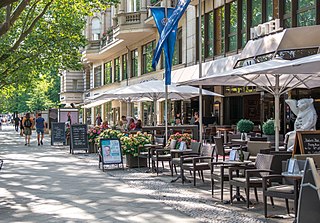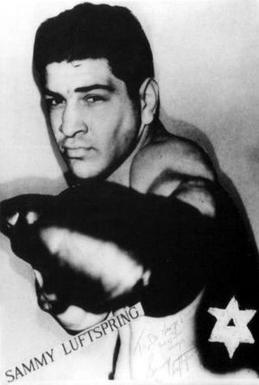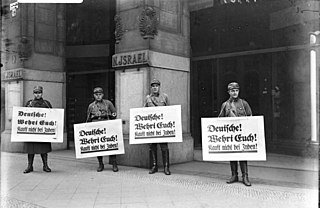
The Kurfürstendamm is one of the most famous avenues in Berlin. The street takes its name from the former Kurfürsten (prince-electors) of Brandenburg. The broad, long boulevard can be considered the Champs-Élysées of Berlin and is lined with shops, houses, hotels and restaurants. In particular, many fashion designers have their shops there, as well as several car manufacturers' show rooms.

Kristallnacht (German pronunciation:[kʁɪsˈtalnaχt]lit. 'crystal night') or the Night of Broken Glass, also called the November pogrom(s) (German: Novemberpogrome, pronounced[noˈvɛm.bɐ.poˌɡʁoːmə] ), was a pogrom against Jews carried out by the Nazi Party's Sturmabteilung (SA) and Schutzstaffel (SS) paramilitary forces along with some participation from the Hitler Youth and German civilians throughout Nazi Germany on 9–10 November 1938. The German authorities looked on without intervening. The euphemistic name Kristallnacht comes from the shards of broken glass that littered the streets after the windows of Jewish-owned stores, buildings, and synagogues were smashed. The pretext for the attacks was the assassination of the German diplomat Ernst vom Rath by Herschel Grynszpan, a 17-year-old German-born Polish Jew living in Paris.

Canadian Jews, whether by culture, ethnicity, or religion, form the fourth largest Jewish community in the world, exceeded only by those in Israel, the United States and France. As of 2021, Statistics Canada listed 335,295 Jews in Canada. This total would account for approximately 1.4% of the Canadian population.

Christie Pits is a public recreational area in Toronto, Ontario, Canada. It is located at 750 Bloor Street West at Christie Street, just west of the Toronto Transit Commission's Christie subway station.

Sammy Luftspring was a Jewish Canadian boxer. A former Canadian Welterweight Champion and highly ranked in the Welterweight class during his career, Luftspring was forced to retire from the sport due to an eye injury. He was inducted into Canada's Sports Hall of Fame in 1985, and the Ontario Sports Hall of Fame in 1996.

The Nazi boycott of Jewish businesses in Germany began on April 1, 1933, and was claimed to be a defensive reaction to the anti-Nazi boycott, which had been initiated in March 1933. It was largely unsuccessful, as the German population continued to use Jewish businesses, but revealed the intent of the Nazis to undermine the viability of Jews in Germany.

Anti-Jewish legislation in pre-war Nazi Germany comprised several laws that segregated the Jews from German society and restricted Jewish people's political, legal and civil rights. Major legislative initiatives included a series of restrictive laws passed in 1933, the Nuremberg Laws of 1935, and a final wave of legislation preceding Germany's entry into World War II.

Different opinions exist among historians regarding the extent of antisemitism in American history and how American antisemitism contrasted with its European counterpart. In contrast to the horrors of European history, John Higham states that in the United States "no decisive event, no deep crisis, no powerful social movement, no great individual is associated primarily with, or significant chiefly because of anti-Semitism." Accordingly, David A. Gerber concludes that antisemitism "has been a distinctly minor feature of the nation's historical development."
"Bobcaygeon" is a song by Canadian rock band the Tragically Hip. It was released in February 1999 as a single from their sixth album, Phantom Power, and has come to be recognized as one of the band's most enduring and beloved signature songs.

The anti-Nazi boycott was an international boycott of German products in response to violence and harassment by members of Adolf Hitler's Nazi Party against Jews following his appointment as Chancellor of Germany on January 30, 1933. Examples of Nazi violence and harassment included placing and throwing stink bombs, picketing, shopper intimidation, humiliation and assaults. The boycott was spearheaded by some Jewish organizations but opposed by others.
Antisemitic incidents escalated worldwide in frequency and intensity during the Gaza War, and were widely considered to be a wave of reprisal attacks in response to the conflict.
Antisemitism in Canada is the manifestation of hostility, prejudice or discrimination against the Canadian Jewish people or Judaism as a religious, ethnic or racial group. This form of racism has affected Jews since Canada's Jewish community was established in the 18th century.
Brigadier-General Dennis Colburn Draper was a Canadian officer who served as the chief constable of the Toronto Police Department from 1928 to 1946.
Toronto's Jewish community is the most populous and one of the oldest in the country, forming a significant part of the history of the Jews in Canada. It numbered about 240,000 in the 2001 census, having overtaken Montreal in the 1970s. As of 2011, the Greater Toronto Area is home to 188,710 Jews. The community in Toronto is composed of many different Jewish ethnic divisions, reflecting waves of immigration which started in the early 19th century. Canada's largest city is a centre of Jewish Canadian culture, and Toronto's Jews have played an important role in the development of the city.

The following events occurred in August 1933:
Antisemitism in South Africa is the manifestation of hostility, prejudice or discrimination against South African Jews or Judaism as a religious, ethnic or racial group. This form of racism has affected Jews since South Africa's Jewish community was established in the 19th century.
The 1918 Toronto anti-Greek riot was a three-day race riot that took place across Toronto, Ontario, Canada, targeting Greek immigrants in early August 1918. The date range of the riots is variously cited as 2–4 August or 1–5 August, with some sources using the latter range to include the event that triggered the violence and the date of the final restoration of the peace. It was the largest riot in the city's history and one of the largest anti-Greek riots in the world. In the newspapers of the time, the events were referred to as the Toronto troubles. The riot was the result of prejudice against new immigrants as well as the false belief that Greeks were not fighting in World War I and held pro-German views.

The Nazi Party and its ideological allies used cartoons and caricatures as a main pillar in their propaganda campaigns. Such techniques were an effective way to spread their ideology throughout Nazi Germany and beyond. The use of caricatures was a popular method within the party when pursuing their campaign against the United States, in particular its then-President Franklin D. Roosevelt.
The Rise Above Movement (RAM) is a militant alt-right Southern California-based street fighting group which has variously been described as "a loose collective of violent neo-Nazis and fascists", white nationalists, white supremacists, and far-right persons. According to the Southern Poverty Law Center (SPLC), it "is inspired by identitarian movements in Europe and it is trying to bring their philosophies and violent tactics to the United States." Its members are primarily located in the areas of Orange County and San Diego, and as of 2018, have been variously numbered at 20 to 50. Individual RAM members are also members of other organizations, such as the self-described Identitarian Identity Evropa/American Identity Movement, the "Western chauvinist" Proud Boys, and the neo-Nazi skinhead Hammerskin Nation, according to Northern California Anti-Racist Action (NoCARA).
The Canadian Nationalist Party was a fascist antisemitic party founded in Winnipeg, Manitoba by William Whittaker, a British ex-soldier who had served with the British Army in India, and a dozen Anglo-Saxon war veterans, in September 1933. The party initially claimed it was for equality of all citizens, but Whittaker was soon condemning Jews in his speeches at public rallies and in the party's newspaper, The Canadian Nationalist, and its other propaganda, leading to opponents confronting him at his rallies and being violently removed, often by police. The organization was modelled on Nazi stormtroopers and would march through Winnipeg's streets wearing khaki shirts, light brown breeches, and riding boots. Whittaker's lieutenant, Harry Simkins, and other CNP members dissatisfied with Whittaker's leadership, left to form the British Empire Union of Fascists in 1934.












